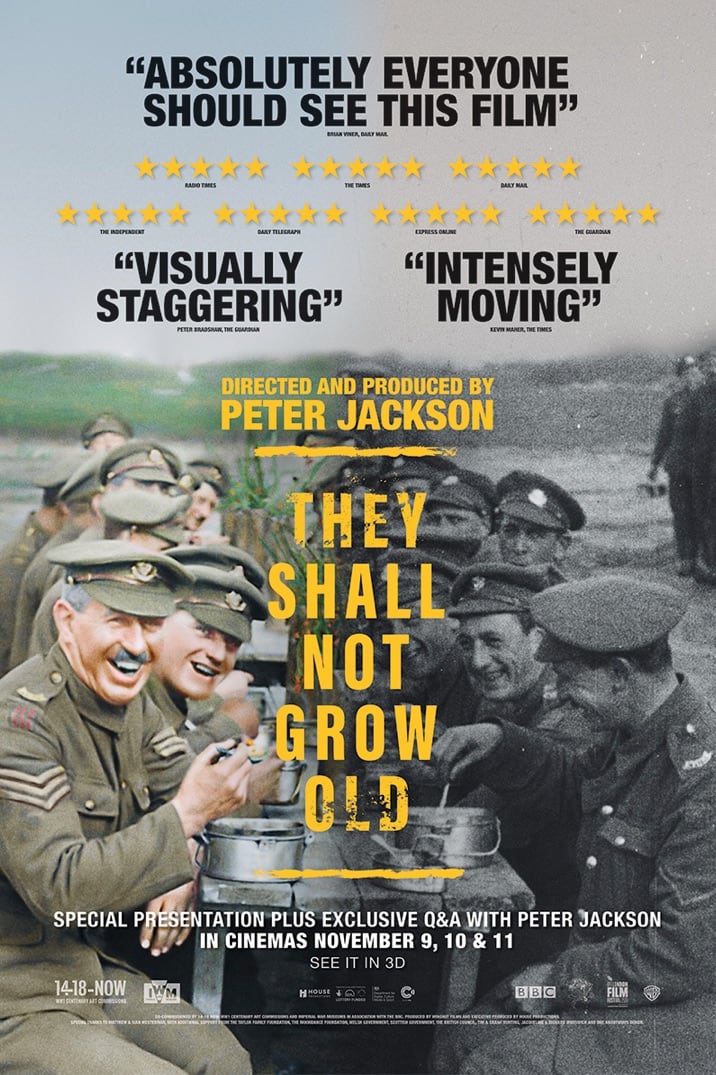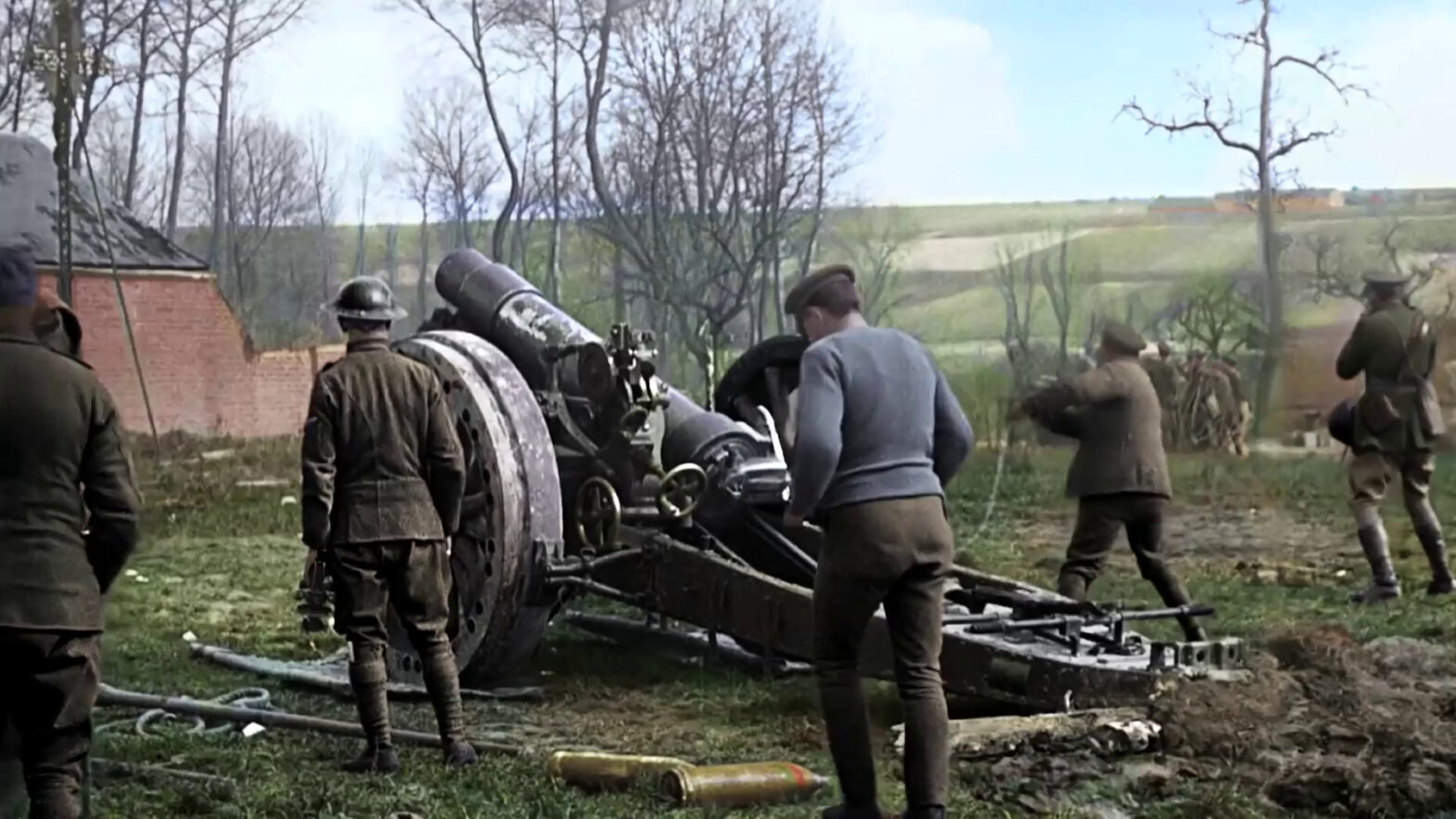In 2014, the British Imperial War Museums approached Peter Jackson, the award-winning director of The Lord of the Rings and The Hobbit trilogies, with a request. They had 100 hours of digitized film footage and 600 hours of audio recordings from World War I of Tommies in the trenches, behind the lines, and in battle. Would Jackson be interested in doing something with it? they asked.
Jackson was, in fact, interested. His grandfather had served in the British Army during the war, and Jackson had a life-long fascination with the war.
He and his team began working on the assets provided by the Museum — cleaning up and restoring the century-old black & white film footage, speed correcting it (and digitally creating interstitial frames) to bring the jerky film footage of 1914-1918 to a consistent 24 frames per second, and colorizing the footage because, as Carbon Leaf sang in one of their most powerful songs, “the war was in color.” The film footage was silent, so lip readers were hired to make out what the soldiers were saying on camera, and their dialogue was recorded. Sound effects of streams and horses, tanks and explosions, were added. The audio recordings of veterans, made decades after the war, were overlaid to provide narration. In short, Jackson and his team worked to bring the experience of the British Tommy back to life — in color, with sound, the way the men in the trenches would have experienced it.
The resulting film, They Shall Not Grow Old, its title taken from Laurence Binyon’s poem, “For the Fallen,” was shown in the United Kingdom in the fall and broadcast on the BBC on November 11th, the centenary of the end of the war. In early November Fathom Events announced 2D and 3D screenings of They Shall Not Grow Old on two nights, December 17th and December 27th. Due to a compressed production schedule at work due to the holidays, not to mention the December and year-end sales reports, the 17th was the more convenient of the two showings for me.
And so it was that last night I saw They Shall Not Grow Old at the Regal Cinemas in Hunt Valley. I opted for the 2D showing; there was enough digital trickery involved in restoring the footage that I felt that 3D would be a step a little too far. I had never been to see a Fathom Events screening before, so this was all new to me. I wasn’t expecting a packed showing — there may have been fifteen empty seats total in the theater — and the man seated next to me told me that he had wanted tickets for the 3D showing, except it had been sold out for two weeks. I had assumed that a documentary on World War I, even one made by Peter Jackson, would be of niche interest. I was pleasantly surprised to be proven wrong.
The film opens with some vintage black and white footage of British soldiers, marching in formation, past a stationary camera. Faces become indistinct as they approach the camera and pass, the frame expands from its original square-ish aspect ration to fill the entire screen, and then we jump back in time, to the summer of 1914, before the war. This is a black and white world, veterans are telling us about how and why they signed up, even how they lied about their ages to join. The veterans speaking aren’t necessarily — and are unlikely to be — the people we see on screen, yet they illustrate and explain what we’re seeing. There’s an amusing anecdote one tells about playing rugby in England against a German squad on the day that war was declared and how, after a conference, everyone decided that, insofar as this match was concerned, the war would start the following morning. We see recruits learning how to stand and how to hold a rifle, receiving their uniforms and mess kits, marching, marching, so much marching. Soon we’re aboard transports, soon we’re in France and Flanders, soon the soldiers are passing towns that have been pounded into ruins by artillery and fighting, soldiers approaching the front pass soldiers pulling out of the lines and heading to the rear, and then…
…it all turns to color.
We’ve seen color in the film to this point — the first twenty minutes were intercut with splashes of color from recruiting posters and books — but to see the front lines, the trenches, No Man’s Land, in full color was staggering. We watch a company of soldiers move into the trenches, and there’s this Tommy with black hair, who couldn’t have been more than about twenty, who keeps staring at the camera and seems deeply unnerved.
And while the only sound we’ve had to this point has been the veterans, recorded decades after the fact, we now have the sounds of life. We hear footsteps splashing in water. We hear wooden wheels cackling over the ground. We hear conversation among the soldiers. We hear the sounds of gunfire and artillery explosions. We hear music and laughter.
For the next hour, we see and hear life on the front lines the way the Tommies would have seen it and heard it. The veterans tell us about how they would run a water-cooled machine gun in the morning so they could make coffee without building a fire (as the smoke would attract sniper fire), or about how the latrines worked. One talked about how often they rotated in and out of the trenches, another talked about how it was basically like camping. They talked about the rain and the cold and how the trenches filled up with water and they would freeze in place, and there were gruesome images of trench foot and gangrene. They talked about how dead bodies would be left where they were, and how sometimes they would decorate a corpse with a pipe and have a laugh.
We see life behind the lines, when the Tommies are “resting” (which was anything but). We see a gas attack on the lines, complete with an anecdote about how one veteran survived one by sticking his head in a bucket of urine when he couldn’t get his gas mask on. We see German mine explosions. We see the first tanks rolling across the ground. We see artillery fire up close.
And we see unfolding, over about fifteen minutes, the preparation for a major push across No Man’s Land — troops moving up to the lines, officers giving speeches to the troops, troops filling the trenches, troops huddled and waiting for the signal to go over the top — and finally the beginning of the attack, led by a company of Scottish soldiers in their kilts. Through it all, the veterans tell us about how they felt, about what they saw, about their comrades cut down, about reaching the German lines, and about the carnage. Here, instead of colorized footage (since footage up close doesn’t exist), Jackson uses images from The War Illustrated, a weekly magazine of the time to tell the story.
After the battle, the veterans tell us about German prisoners, about how soldiers from Bavaria and Saxony were alright blokes but the soldiers from Prussia were vicious bastards, against footage of British Tommies fraternizing with their prisoners.
Then the Armistice comes, the guns fall silent, and the film returns to black and white.
We see life in England after the war, and the veterans tell us about readjusting to life after war. “War was all I knew,” says one. “My parents never asked me about it, and they wouldn’t have been able to understand,” says another. “I slept in a bed for the first time in four years, and when my mother woke me the next morning, I was sleeping on the floor,” says a third. That, essentially, is how the film ends.
I went into some detail about the way the film is told because They Shall Not Grow Old is not a conventional World War I documentary. This isn’t a film concerned with the assassination of Archduke Ferdinand or the neutrality of Belgium. Tactics and strategy don’t matter here. This isn’t a specialist’s film; Jackson said in the making-of documentary after the film that this was “a documentary made by a non-historian for non-historians.” This is a film about life in the trenches, as seen by the soldiers of the First World War. This is about the things they saw and the things they felt. This is about what their life was like and how it forever changed them. They saw the war in color and in stereo, but the film we have of the war is in silent black and white. Thanks to Jackson, we now see and hear the war the way the Tommies did, and we see them as individuals, some of them very young, in a foreign land, facing death on a regular basis in nigh-unimaginable circumstances and coping as best they could.
I liked They Shall Not Grow Old a lot, but I felt curiously distant from it while watching it. Others in the theater would laugh at something — there are times where one of the veterans says something absurdist — and it wouldn’t strike me that way. I was also occasionally conscious of the artifice at work here — a face would turn fuzzy, eyes would look flat or wouldn’t move correctly, fixing bayonets on a rifle wouldn’t look fluid — and that would take me out of the film’s reality. I was more moved by Jackson, in the post-film documentary, talking about one particular scene, of a company huddling in a sunken road before going over the top at (I believe) the Somme, and how everyone in that scene, some of whom looked absolutely terrified, would have been dead half an hour after this film was shot, something the film, because of the way it was structured, would have been unable to say as directly.
Before the film, there were title cards of trivia relating to World War I, and one of the questions asked which fantasy author Jackson had adapted to film — C.S. Lewis, J.R.R. Tolkien, and J.K. Rowling. The answer, of course, is Tolkien; Jackson adapted both The Hobbit and The Lord of the Rings. Tolkien was shaped by the First World War — he survived the Somme, and Middle-Earth began as stories he wrote during his convalescence — and there are places where you can see the influence of the war on The Lord of the Rings, most notably the Paths of the Death. Jackson called this his “most personal film” — it’s a tribute to his own grandfather, who took machine gun fire at the Somme — and he’s said that he now understands better what his grandfather experienced in the trenches. They Shall Not Grow Old also shows what Tolkien saw and heard in 1916, and as Middle-Earth was shaped by the First World War this film makes an interesting bookend to Jackson’s Middle-Earth work.
They Shall Not Grow Old is an incredible technical achievement.
I had heard some recordings of veterans (I listened to the BBC’s Voices of the First World War podcast the last four years), but I wasn’t familiar with extant film footage of the war, so that was all new to me. Still photographs and narrative histories don’t compare to seeing in this way. World War I has passed from living memory, and this film brings it back to life as best we can, so we can understand why something like it will never happen again. If you have any passing interest in World War I, if your ancestors fought in it, see the film so you can understand what it was like.

